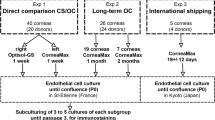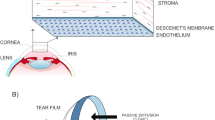Abstract
Human corneas usually are not available for research, as they are used for transplantation only. At the same time, scientific studies on cultured human endothelial cells can produce misleading results due to inevitable dedifferentiation. Therefore, an organ-culture model of porcine corneas—displaying endothelial cell death rates comparable to those of cultured human corneas—would be very desirable. Fresh pig eyes were prepared under sterile conditions to obtain corneoscleral buttons, corneal buttons and so called “split corneal buttons” (new preparation method) and cultivated for 15 days. Morphology of the endothelial cell layer was observed by light microscopy on day 1, 8 and 15. On day 15 staining with trypan blue and alizarin red S was performed. Photographs were evaluated in a randomized, blinded manner. Here, the morphology of the corneal endothelium and the number of endothelial cells per mm2 were analyzed. After 15 days of cultivation the endothelial cell layer was maintained only in corneal buttons and split corneal buttons. Alizarin red S stained areas and the existence of polymorphisms like rosette figures and reformation figures were significantly less frequent in split corneal buttons than in corneal buttons. Loss of endothelial cells was significantly greater in corneal buttons [575 ± 25/250 cells/mm2 (median ± 25%/75%-quantile); 14.8%] than in split corneal buttons [417 ± 138/179 cells/mm2 (median ± 25%/75%-quantile); 10.2%]. The new preparation method of split corneal buttons allows the cultivation of porcine corneas for 2 weeks with cell death rates comparable to those of the corresponding human tissue in cornea banks without the need to add de-swelling additives to the media. This is therefore a simple and highly reliable method model to be applied in intervention studies on corneal endothelial cells in their natural compound.




Similar content being viewed by others
References
Albon J, Tullo AB, Aktar S, Boulton ME (2000) Apoptosis in the endothelium of human corneas for transplantation. Invest Ophthalmol Vis Sci 41(10):2887–2893
Borderie VM, Kantelip BM, Delbosc BY, Oppermann MT, Laroche L (1995) Morphology, histology, and ultrastructure of human C31 organ-cultured corneas. Cornea 14(3):300–310
Bourne RR, Minassian DC, Dart JK, Rosen P, Kaushal S, Wingate N (2004) Effect of cataract surgery on the corneal endothelium: modern phacoemulsification compared with extracapsular cataract surgery. Ophthalmology 111(4):679–685
Filev F, Oezcan C, Feuerstacke J, Linke SJ, Wulff B, Hellwinkel OJ (2017) Semi-quantitative assessment of dextran toxicity on corneal endothelium: conceptual design of a predictive algorithm. Cell Tissue Bank 18(1):91–98. doi:10.1007/s10561-016-9596-z
Fujita M, Mehra R, Lee SE, Roh DS, Long C, Funderburgh JL, Ayares DL, Cooper DK, Hara H (2013) Comparison of proliferative capacity of genetically-engineered pig and human corneal endothelial cells. Ophthalmic Res 49(3):127–138. doi:10.1159/000342978
Gain P, Thuret G, Chiquet C, Dumollard JM, Mosnier JF, Burillon C, Delbosc B, Hervé P, Campos L (2002) Value of two mortality assessment techniques for organ cultured corneal endothelium: trypan blue versus TUNEL technique. Br J Ophthalmol 86(3):306–310
Jacobsen U, Michels G, Liedtke G, Muller MC, Reim M (1985) Organ-culture of pig cornea-methods, clinical morphology and histology. Ophthalmic Res 17(4):201
Komuro A, Hodge DO, Gores GJ, Bourne WM (1999) Cell death during corneal storage at 4 °C. Invest Ophthalmol Vis Sci 40(12):2827–2832
Lee SE, Mehra R, Fujita M, Roh DS, Long C, Lee W, Funderburgh JL, Avares DL, Cooper DK, Hara H (2014) Characterization of porcine corneal endothelium for xenotransplantation. Semin Ophthalmol 29(3):127–135. doi:10.3109/08820538.2013.787104
Linke SJ, Eddy MT, Bednarz J, Fricke OH, Wulff B, Schröder AS, Hassenstein A, Klemm M, Püschel K, Richard G, Hellwinkel OJ (2013) Thirty years of cornea cultivation: long-term experience in a single eye bank. Acta Ophthalmol 91(6):571–578. doi:10.1111/j.1755-3768.2012.02471.x
Meltendorf C, Ohrloff C, Rieck P, Schroeter J (2007) Endothelial cell density in porcine corneas after exposure to hypotonic solutions. Graefes Arch Clin Exp Ophthalmol 245(1):143–147
Park CY, Lee JK, Gore PK, Lim CY, Chuck RS (2015) Keratoplasty in the United States: a 10-year review from 2005 through 2014. Ophthalmology 122(12):2432–2442. doi:10.1016/j.ophtha.2015.08.017
Reim M, Althoff C, von Mulert B (1988) Effect of low temperatures on the metabolism of corneal cultures. Graefes Arch Clin Exp Ophthalmol 226(4):353–356
Roy O, Leclerc VB, Bourget JM, Theriault M, Proulx S (2015) Understanding the process of corneal endothelial morphological change in vitro. Invest Ophthalmol Vis Sci 56(2):1228–1237. doi:10.1167/iovs.14-16166
Schroeter J, Rieck P (2009) Endothelial evaluation in the cornea bank. Dev Ophthalmol 43:47–62. doi:10.1159/000223838
Schroeter J, Meltendorf C, Ohrloff C, Rieck P (2008) Influence of temporary hypothermia on corneal endothelial cell density during organ culture preservation. Graefes Arch Clin Exp Ophthalmol 246(3):369–372
Schroeter J, Ruggeri A, Thieme H, Meltendorf C (2015) Impact of temporary hyperthermia on corneal endothelial cell survival during organ culture preservation. Graefes Arch Clin Exp Ophthalmol 253(5):753–758. doi:10.1007/s00417-014-2903-0
Taylor MJ, Hunt CJ (1981) Dual staining of corneal endothelium with trypan blue and alizarin red S: importance of pH for the dye-lake reaction. Br J Ophthalmol 65(12):815–819
Thuret G, Manissolle C, Campos-Guyotat L, Guyotat D, Gain P (2005) Animal compound-free medium and poloxamer for human corneal organ culture and deswelling. Invest Ophthalmol Vis Sci 46(3):816–822
Zhao M, Campolmi N, Thuret G, Piselli S, Acquart S, Peoc’h M, Gain P (2012) Poloxamines for deswelling of organ-cultured corneas. Ophthalmic Res 48(3):124–133. doi:10.1159/000334981
Acknowledgements
The work has been supported by KMU-innovativ (FKZ: 13GW0037F) of the Federal Ministry of Education and Research Germany.
Author information
Authors and Affiliations
Corresponding author
Ethics declarations
Conflict of interest
The authors declare that they have no conflict of interest.
Rights and permissions
About this article
Cite this article
Kunzmann, B.C., Hellwinkel, O.J.C., Klameth, C. et al. Establishment of a porcine corneal endothelial organ culture model for research purposes. Cell Tissue Bank 19, 269–276 (2018). https://doi.org/10.1007/s10561-017-9669-7
Received:
Accepted:
Published:
Issue Date:
DOI: https://doi.org/10.1007/s10561-017-9669-7




